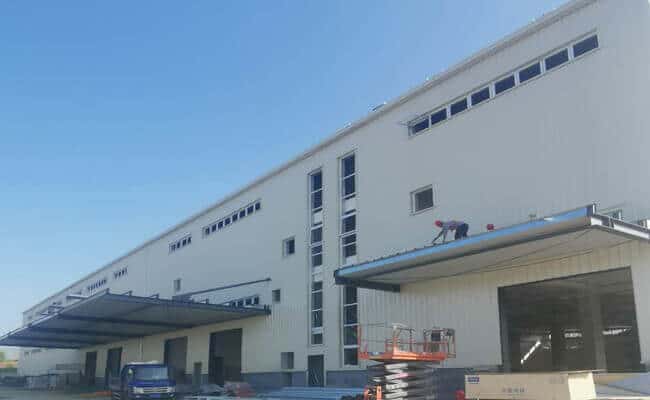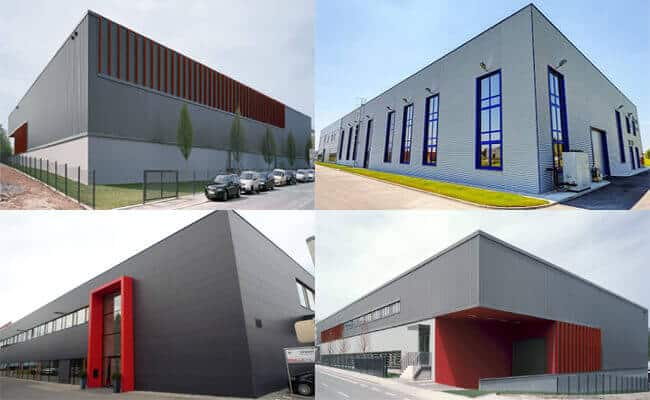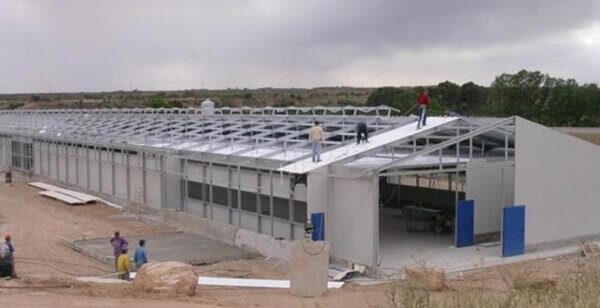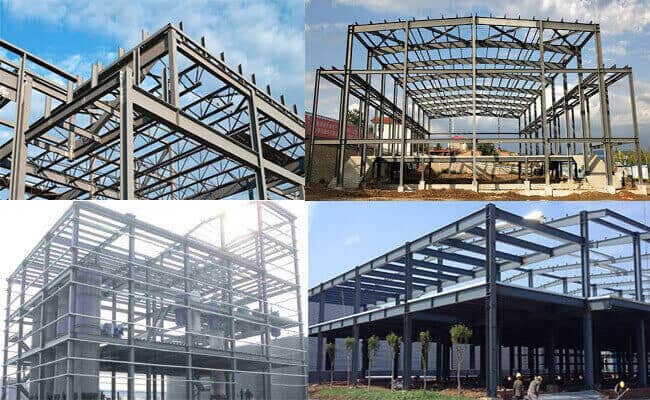Steel Warehouse Building
The steel structure warehouse building designed by ZHM Steel provides customers with ideal storage and cargo management solutions.
With the steel structure warehouse building, customers can choose from a variety of structures, ranging from simple two-bay warehouses to large industrial and commercial buildings. The steel frame of this prefab warehouse is unique in that it can be built within a short period of time without any trouble involved. Furthermore, this kind of storage center benefits from extremely low maintenance costs and can withstand even harsh weather conditions.
The Prefab steel structure warehouse is custom-designed to meet any industrial or commercial storage needs. This steel structure warehouse building supports any crane with different lifting capacities and can accommodate vehicular traffic on the ground level. The warehouse building is specifically designed for large and medium-sized warehouses. By enclosing the main steel frame with wall and roof, it can provide an enclosed structure for indoor storage of goods. A mezzanine area can be used as an office to meet the needs of material transportation, storage and processing.
Steel structure warehouse building is structural frames made of primary steel columns, beam, and secondary structure, which can be used as enclosures to accommodate electrical and plumbing facilities. One main concept of steel structure warehouse buildings is that they use a wide span, so a single bay space can be divided into multiple small rooms without having an outer column for support. That advantage will save the construction cost, which is especially suitable for large warehouses and huge factories since it takes up less land than traditional construction methods.
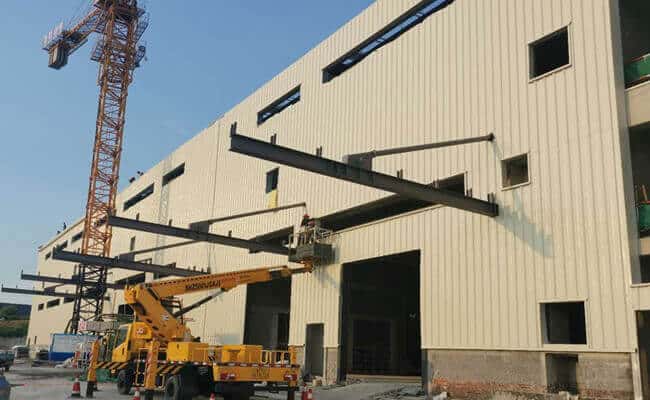
Prefab Steel Warehouse
The components of Steel Warehouse Building:
The various components or parts are connected by welding, bolting, or rivets.
The main structure includes steel columns and beams, which are primary load-bearing structures. It is usually processed from steel plate or section steel to bear the entire building itself and external loads. The main structure adopts Q345B steel.
Made of thin-walled steel, such as purlins, wall girts, and bracing. The secondary structure helps the main structure and transfers the main structure’s load to the foundation to stabilize the entire building.
The roof and wall adopt corrugated single color sheets and sandwich panels, which overlap each other during the installation process so that the building forms a closed structure.
Used to fix various components. Bolt connection can reduce on-site welding, making the installation of steel structure easier and faster.

Basic knowledge of steel structure warehouse building
1. Site selection of steel warehouse building: The location of the warehouse should be a place with simple, open terrain and no accumulation of water to facilitate cargo transportation and site drainage. The aspect ratio of the warehouse is controlled at 1:1.5, which is more economical and reasonable.
2. Pay attention to the load-bearing design: When designing the warehouse, the load-bearing must be considered, combined with local climate conditions, and pay attention to the effects of rain, snow pressure, construction load, maintenance load, and strong wind. Ensure warehouse safety in extreme climates.
3. Pay attention to the lighting layout of the warehouse: The lighting design is reasonable and can save energy. Of course, a proper lighting layout must be carried out according to the nature of the goods that need to be stored. You cannot design too many glass windows if many goods must be kept from light.
4. How to prevent moisture in steel warehouse buildings:
Moisture-proof warehouses can prevent goods from becoming moldy and deteriorating and can also deter warehouses from rusting and corroding. Therefore, it is essential to take necessary moisture-proof measures.
Steel warehouse buildings can use moisture-proof materials like membranes, waterproof coatings, etc.
Also, maintain good ventilation, control the humidity in the warehouse, and use a dehumidifier if necessary.
Install shelves in the warehouse, and try to place the goods on the shelves and not close to the ground. The ground can use moisture-proof flooring or a waterproof layer on the bottom to prevent water seepage from the setting.
Regularly check whether there are leaks in the warehouse and repair them in time.
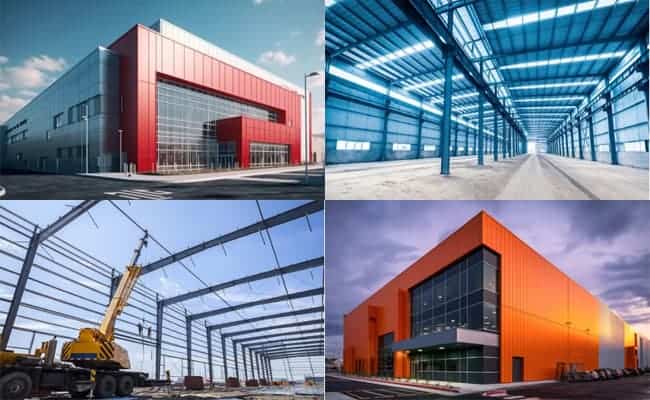
5. How to prevent water leakage in steel warehouse building:
The biggest fear of any building is a leaky roof. Warehouses are where goods are stored, and water leaks can cause substantial property losses. Therefore, water leakage prevention is one of the factors that must be considered.
2) Install drainage system: Design a reasonable drainage system for the warehouse, such as rain troughs, gutters, drainage pipes, etc., to prevent accumulation caused by excessive rain and insufficient drainage in time, guide water to flow down from drains and drainage pipes, and do not cause damage to roof panels and Damage to wall panels.
3) Choose high-quality waterproof materials: Choose high-quality waterproof materials for roofs and walls to ensure no water seepage.
4) Sealing seams and connections: Especially at the joints of roof components, necessary sealing must be carried out in advance to prevent roof leakage.
5) Regular maintenance and inspection: Inspect roofs, walls, etc., discover damage or potential leakage problems, and repair them promptly.
6. How to prevent fire in steel structure warehouse building:
1) Use fire-retardant coatings: Coating the surface of steel structures with fire-retardant layers can provide fire protection and delay the spread of fire.
2) Install smoke detectors and fire alarm systems to ensure fires are discovered and extinguished immediately. And be equipped with necessary fire-fighting equipment.
3) Place goods reasonably and reserve fire escapes. Conduct regular fire safety training for employees, use of fire extinguishers, and exit methods.
Of course, other factors must be considered when constructing a steel warehouse building and other requirements put forward by the owner. The above factors must be taken into consideration. The more comprehensive the issues are considered during design, the more reasonable, safer, and practical the warehouse can be designed!
Steel Warehouse Building VS Ordinary Buildings:
Moreover, the technical requirements for assembling this prefabricated steel warehouse are not high. Almost anyone can do it, thus reducing labor costs and saving time.
Steel structure warehouse is a prefabricated building material. It has high strength and easy assembly so that it can be assembled quickly. The construction period of the steel warehouse is generally much shorter than conventional construction. Professional engineers design the steel structure warehouse according to different needs, saving you much time on building and significantly reducing your costs.
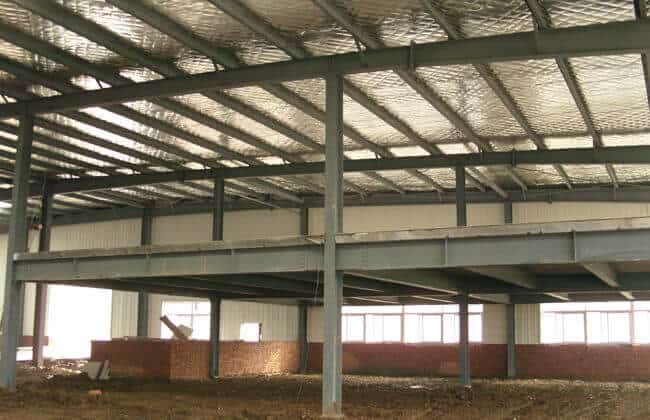
Mezzanine Floor
The Characteristics of Steel Structure
1. The steel structure is small and light in weight, convenient for transportation and installation, as well as for assembly, disassembly, and expansion. It is suitable for structures with a large span, high height, and heavy load.
2. Steel has a high strength and light structure. Compared with masonry and wood structures, steel has higher density but higher strength, so the ratio of density to strength is smaller. Under the same load, the steel structure is better than other structures.
3. The steel has high strength, good plasticity and toughness, and strong resistance to impact and vibration.
4. The high degree of industrialization of steel structure, factory manufacturing, site installation, high processing accuracy, short manufacturing cycle, high production efficiency, and fast construction speed; steel structure buildings have strong platform structures, roof structures, tall background walls, etc. The sense of time and changeable appearance are suitable for expressing the imagination of designers.
5. Residual materials and debris generated in steel structure processing and manufacturing and abandoned and damaged steel structures can be re-smelted into steel for reuse. Therefore, steel is called green building materials or sustainable materials.
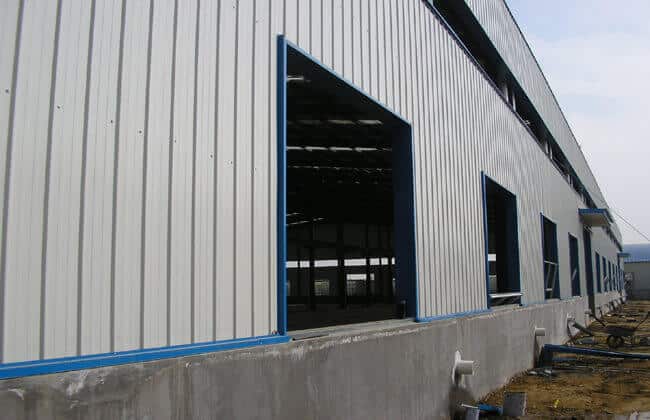
Prefab Steel Building
The Advantage
Fast delivery:
Sturdy:
Wide internal space:
The rigid steel frame is solid and can cover a larger area without internal support columns, which gives warehouse operations greater flexibility in storing and moving products quickly and efficiently.
Easy installation:
